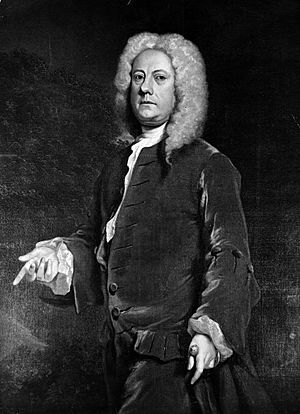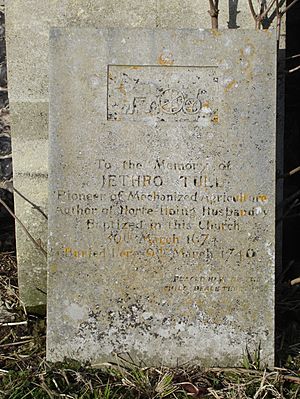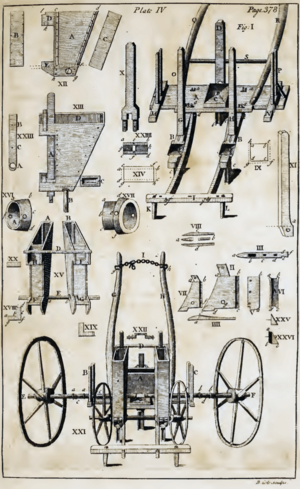Jethro Tull (agriculturist) facts for kids
Quick facts for kids
Jethro Tull
|
|
|---|---|
 |
|
| Born | 1674 Basildon, Berkshire, England
|
| Died | 21 February 1741 (aged 66) Shalbourne, Berkshire, England
|
| Resting place | St Bartholomew's Church, Lower Basildon, Berkshire, England |
| Nationality | English |
| Known for | Agricultural reforms and inventions, such as the seed drill and horse-drawn hoe |
Jethro Tull (born in 1674, died in 1741) was an English farmer and inventor. He lived in Berkshire, England. Tull played a big part in the British Agricultural Revolution of the 1700s.
He made a special machine called a seed drill in 1701. This machine planted seeds neatly in rows. Later, he also created a horse-drawn hoe. Many farmers started using Tull's new methods. His ideas helped create the way we farm today.
Contents
About Jethro Tull's Life
Jethro Tull was likely born in Basildon, Berkshire. His parents were Jethro Tull, Sr., and Dorothy Buckeridge. He was baptized there on March 30, 1674.
He grew up in Bradfield, Berkshire. At age 17, he started studying at St John's College, Oxford. He studied law but did not finish his degree. In 1693, he became a lawyer.
Tull married Susanna Smith. They lived on his father's farm in Howberry, near Crowmarsh Gifford. They had one son and two daughters.
Travels and New Ideas
After becoming a lawyer, Tull got sick with a lung illness. He traveled around Europe to find a cure. He spent a lot of time in Montpellier, France.
During his travels, Tull carefully looked at farming in France and Italy. He compared it to farming in England. He noticed that farmers in France used similar methods for their vineyards. They often stirred the soil around their plants.
These farmers also did not use much manure in their vineyards. This made Tull think that adding manure to soil wasn't always needed.
Returning to Farming
In 1709, Tull came back to England. He took over a farm called Prosperous in Shalbourne. Here, he continued his farming experiments.
He wrote a famous book called Horse-hoeing Husbandry in 1731. From 1730 to 1740, Tull worked hard to get farmers to use his new machines. He especially wanted them to use the horse-hoe.
Jethro Tull died on February 21, 1741, at Prosperous Farm. He is buried in the churchyard of St Bartholomew's Church, Lower Basildon. This is the same church where he was baptized.

Jethro Tull's Inventions and Ideas
Tull wanted to learn more about farming during his travels. He was influenced by the Age of Enlightenment. This was a time when people started using science and experiments to understand the world.
Tull is seen as one of the first people to use a scientific approach to farming. He improved farming methods by inventing new tools.
The Seed Drill
Tull made big progress in planting crops with his seed drill. He invented it in 1701. This machine planted seeds well, at the right depth and with good spacing. It also covered the seeds so they could grow.
Before the seed drill, farmers usually threw seeds by hand. This was called broadcasting. Then they would lightly rake the soil to cover the seeds.
Tull wrote in 1731 that he developed the seed drill because of problems with his farm workers. They didn't want to use his new methods. They also didn't like that his machines might make their skills less important.
Drill Farming Machines
Around 1733, Tull invented machines for his "drill husbandry" system. His first invention was a drill-plough. It could plant wheat and turnip seeds in three rows at once.
This machine had two boxes for seeds. The parts that cut the soil were placed one behind the other. This allowed two different kinds of seeds to be planted at the same time. A harrow was attached behind to cover the seeds.
Tull also invented a turnip-drill. It was lighter but worked similarly. It dropped half the seeds after the soil fell into the row. This made some seeds sprout earlier. This helped protect them from the turnip fly.
Tull was the first to use special notched barrels to deliver seeds. These barrels had small holes on their surfaces.
Tull's Ideas on Soil
Tull believed that soil was the only food for plants. He wrote that plants could never have "too much earth." He thought that fine soil was the best for plants.
He believed that plants took tiny particles of earth from the soil's pores. He thought this was how plants grew.
Tull was very excited about his ideas. He thought that finely breaking up the soil would make it very fertile. He didn't fully understand that soil has many other things besides just earth. He also didn't realize that these other things are often very important for plant growth.
Later, scientists learned that plants need more than just earth. They need things like lime, silica, magnesia, and alumina. These are often found in healthy soil.
Benefits of Hoeing
Hoeing is when you use a tool to break up the soil. It helps in two ways. First, it gets rid of weeds. Weeds can steal food and water from crops. Second, it loosens the soil surface. This lets air and water get to the plant roots more easily.
Tull was the first to teach farmers about the benefits of hoeing. He explained that hoed ground doesn't stay wet for too long after rain. He also said that even in dry weather, good hoeing brings moisture to the roots. Many people at the time didn't understand this.
Jethro Tull's Lasting Impact
Tull's work started a new way of farming in the 1700s. It was called "horse-hoeing husbandry" or "new husbandry." Many people supported his system, including farmers in France and Switzerland.
His system brought two big changes:
- Scarifiers and horse hoes: These tools were new in the 1700s. People had hoed by hand for a long time to remove weeds. But Jethro Tull was the first to show how important frequent hoeing was. He taught that it not only removed weeds but also broke up the soil. This helped air and moisture reach the plant roots better.
- The use of drills: Planting seeds in rows was not new. But Tull made it much more popular in England in 1731. It didn't become widely used until the early 1800s. By then, there were many improved machines for planting different crops.
Tull thought that working the soil enough could replace the need for manure. This led to his "horse-hoeing husbandry." At first, this system worked very well. The plants grew strong. But eventually, the soil became tired. Even Tull's biggest supporters found that breaking up the soil alone wasn't enough to keep it fertile.
However, when drilling and horse-hoeing were combined with smart use of manure, farming greatly improved. Tull's book also influenced how cotton was grown in the American Southern Colonies. His system taught that planting seeds at regular distances was important for a good harvest.
Tull's Farm Today
After Tull died, his farm in Berkshire was sold in 1784. The old brew-house where he lived was updated but still mostly stands. His granary and stables also remain, though they are getting old.
An old well at the granary was cleaned out years ago. Inside, they found a three-pronged hoe. It probably belonged to Tull. It is now in a museum. His workers were said to have disliked new tools and often tried to stop him.
Tull's Prosperous Farm in Shalbourne is still a place of interest for people who love farming history. The farmhouse was rebuilt in the 1800s.
Literary Mentions
Jethro Tull was mentioned in a novel called The Expedition of Humphry Clinker. It was written by Tobias Smollett in 1771.
See also
 In Spanish: Jethro Tull (agrónomo) para niños
In Spanish: Jethro Tull (agrónomo) para niños


